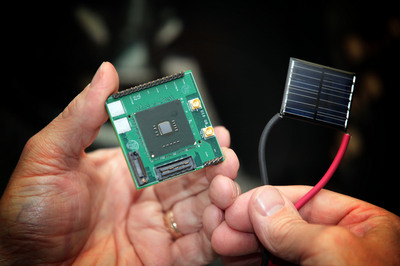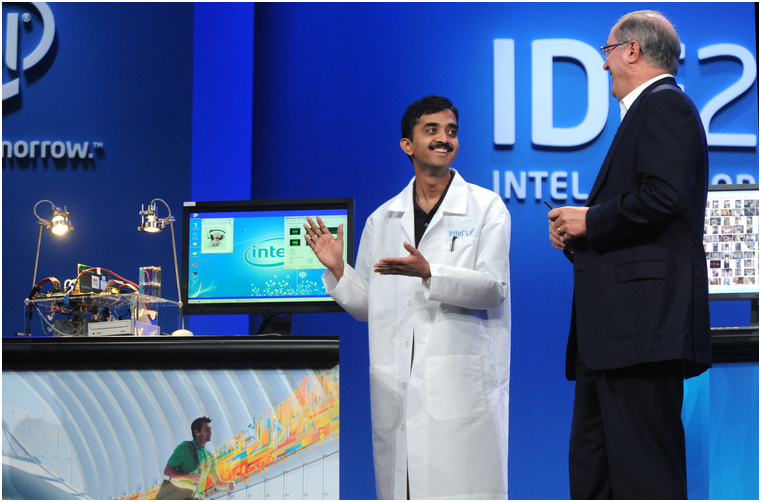What technology has reached
 I have written quite a few words in defense of energy efficiency, which is often called the “fifth type of fuel” - today all developments in the field of reducing the energy consumption of microcircuits, as well as new developments, including processors operating at minimum voltage, are almost the most priority at Intel. We already know that it is impossible to increase power indefinitely by increasing the number of transistors on a silicon substrate, as well as the fact that multi-streaming has its own theoretical ceiling. In any case, peak performance at the moment is critical except for the builders of supercomputers - the average user has long enough of the frequencies that are provided in abundance by vendors.
I have written quite a few words in defense of energy efficiency, which is often called the “fifth type of fuel” - today all developments in the field of reducing the energy consumption of microcircuits, as well as new developments, including processors operating at minimum voltage, are almost the most priority at Intel. We already know that it is impossible to increase power indefinitely by increasing the number of transistors on a silicon substrate, as well as the fact that multi-streaming has its own theoretical ceiling. In any case, peak performance at the moment is critical except for the builders of supercomputers - the average user has long enough of the frequencies that are provided in abundance by vendors.For this reason, reducing the need for high voltage is a promising area, which in the foreseeable future will allow mobile devices, laptops, and even desktop or server solutions, to significantly reduce energy consumption, and hence the electricity bill. Moreover, today Intel researchers are showing finished products that require a postage stamp-sized solar cell to operate.
Let's start with this.
IDF 2011 may not have brought any revolution in the field of processor building, but it clearly opened the eyes of the general public to the widespread use of low-voltage processors. As proof of this - the effect that the presentation of the experimental chip produced using the so-called. NTV (near-threshold voltage, near-threshold voltage). This processor, codenamed “Claremont”, requires minimal energy to start the calculations (the threshold value of the semiconductor switch-on), and in fact it can be powered by an extremely compact and economical source of energy: from the solar cell — as has been demonstrated, up to, theoretically, potatoes or lemon.
')
At the demonstration, the processor showed the work of a personal computer based on Linux and was powered by a tiny solar battery. In addition, another novelty - the so-called. Hybrid Memory Cube (experimental DRAM memory built on the three-dimensional principle) worked together with the Claremont processor, demonstrating not only low power consumption, but also the possibility of reaching medium or high performance if necessary. Fortunately, the potential of both systems is really high.

Intel speaker Connie Brown said in an interview that "a solar cell of such small size was used specifically to show how low the voltage is enough for the operation of this system." And although Claremont is only an experimental model, this experience will be reflected in the work of future processors, which are planned with preservation of the tradition of reducing energy dependence.
In order to achieve this result, Intel specialists took several years, so in fact, the Claremont architecture is quite simple and resembles Pentium chips rather than the latest generation of processors. But the technology of transition to ultra-low voltage, when the processor load is minimal, will be used in future generations of Intel processors. Claremont has shown that it can operate with a consumption of less than 10 milliwatts, accelerating 10 times as necessary with increasing power consumption.
That is, it is not even “work” at all. Instead of completely shutting down, the processor allows the device to enter the ultra-economical mode, which will extend the autonomous operation of future devices with extended uptime without recharging - such are planned to be done by ultrabooks, which will allow to work in the background (with the lid closed) for up to 10 days, getting mail, news from the Internet and various updates. This technology is also used by Intel to create “zero-power” architectures - it is possible that in 5 years our devices will not have to be connected to the power grid, and they will be charged by vibration or movement and, finally, solar energy.
The result of applying the new approaches in the Claremont prototype in dry numbers is that it consumes 5-10 times (depending on the workload / task) less energy than the most modern processors.
Sriram Vangal (pictured above) says that “most digital devices today operate with a nominal voltage of 1 volt. NTV operates at between 400 and 500 millivolts. ” But it is difficult to constantly maintain the device in such conditions - the difference between 0 and 1 is becoming increasingly blurred, in the sense of the presence and / or absence of an electrical signal.
As I have already noted, this is progress not only in the field of consumer technology of the future, but also in high-performance systems. The company's goal is to reduce the power consumption of processors by 300 times in 10 years. This is a very ambitious goal, on a large scale - today, in order to get 100 gigaflops of performance, you need to spend about 200 watts of power at the output, while Intel hopes to reduce this number to at least 2 watts over time.
 The second, perhaps even more interesting in a sense, novelty, was the Hybrid Memory Cube - a block of RAM, made by a new technology using a microprocessor that controls the work of the entire memory chip.
The second, perhaps even more interesting in a sense, novelty, was the Hybrid Memory Cube - a block of RAM, made by a new technology using a microprocessor that controls the work of the entire memory chip.Actually, the production of RAM was simply a limitation - even with the release of DDR-3, companies could not achieve a serious increase in productivity by improving the technological process of its production. Therefore, Intel decided to go the beaten path and created a memory module manufactured using 3D technology - just like the future Ivy Bridge processors. This allowed to increase the density of transistors, reduce its power consumption, as well as increase the bus speed, at a logical level.
 The result of cooperation with Micron Technology was the emergence of a completely new memory form factor - a hybrid cube, which has become the fastest DRAM device in the world with a data transfer rate of 1 terabit per second. In addition, it is the most energy-efficient DRAM module in the world, which consumes much less energy compared to the most popular and efficient memory models. As a result, Hybrid Memory Cube is almost ten times faster and 7 times more economical than the most advanced DDR3 module on the market.
The result of cooperation with Micron Technology was the emergence of a completely new memory form factor - a hybrid cube, which has become the fastest DRAM device in the world with a data transfer rate of 1 terabit per second. In addition, it is the most energy-efficient DRAM module in the world, which consumes much less energy compared to the most popular and efficient memory models. As a result, Hybrid Memory Cube is almost ten times faster and 7 times more economical than the most advanced DDR3 module on the market.It is not yet clear whether the new solution will be reflected in mid-level systems (such as home computers) in the near future, but many server manufacturers have already expressed their desire to apply this development. It is possible that the HMC will be a serious step in building data centers and supercomputers of the future, as powerful as they are economical. Architects of such systems will no longer be limited by the performance of memory, which means they will be able to increase the scalability of all systems without a serious blow to their pockets due to the gluttony of chips.
Source: https://habr.com/ru/post/130179/
All Articles